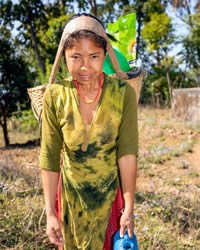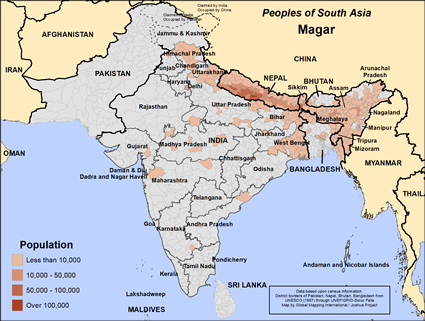Magar origin is unclear. They are probably of Tibetan descent because their language and dances are like those within the Tibetan culture. Some of the Magar live in the plains where the Himalayan foothills begin. Others occupy the lower hills of the Mahabharat Lekh while a few inhabit the high altitude mountain areas. Most live in the Himalayan regions of Nepal, Bhutan and India. A smaller number are in Bangladesh.
There are two major groups of Magar (the Eastern and Western) and which are further divided into a number of clans. The Magar language, which is divided into four groups, gives the people a distinct tribal identity. This linguistic classification is important in understanding the Magar tribes.
Most Magar are craftsmen, although some who own their land have become farmers. Others work as miners, blacksmiths or basket weavers. They tend to be hard-working, honest, self-reliant and self-sufficient people. They are very jovial and love to sing and dance. They have several kinds of dances as well as tribal games that they frequently play.
The Magar typically live in large, two-story stone houses with slate or thatch roofs. The homes often have large porches.
The Magar have a unique style of dress. Commonly they wear loin cloths and bhotos (shirts with sleeves), or shirts and coats. The women also wear loin cloths called dhotis. They often adorn themselves with fulis (flower-like ear ornaments) in the middle parts of their ears and necklaces made of glass beads and silver Indian coins. Some aspects of western style clothing are slowly becoming more common.
Magar marriages are arranged in a unique fashion. The groom's brother-in-law must go to the bride's family and offer a "bride price" of money and alcohol. If the proposal is accepted, further payments are then made. Marriages to maternal first cousins are the most common arrangements.
The most distinctive element in the Magar family kinship is the strong bond between maternal uncles and their nephews. They treat each other with mutual respect because when the nephew is ready to marry, his bride will be chosen from among his uncle's daughters.
"Life cycle rituals" are a very important part of Magar society. A special birth ceremony is held eleven days after a child is born. The baby is named and then washed for the first time. One festival known as Jyestha Poornima is observed in May or June at the time of the full moon. During the ceremony, freshly harvested grains are offered to the gods.
The great majority of the Magar practice ethnic religions, while the minority are practicing Hindus. Like other Magar groups, Hinduism has greatly influenced the Eastern Magar. Many now worship the three major Hindu gods: Brahma (creator of the universe), Vishnu (protector and preserver of the worlds), and Shiva (the destroyer), as well as a host of other deities.
The New Testament has been translated into the Eastern Magar language. There are only a few known Eastern Magar believers.
Nepal has long been hidden away and forgotten by most of the world. The government of Nepal is opposed to any form of proselytizing; and so government restrictions apply, but most of the time Christians can follow their religion. There is more opposition from family members than from the government.
Ask God to give the few Magar believers opportunities to share the gospel with their own people.
Pray that the Lord of the harvest will thrust forth laborers into Magar communities in Nepal and India.
Ask the Lord to raise up strong local churches among the Magar people in India.
Scripture Prayers for the Magar in India.
| Profile Source: Joshua Project |













